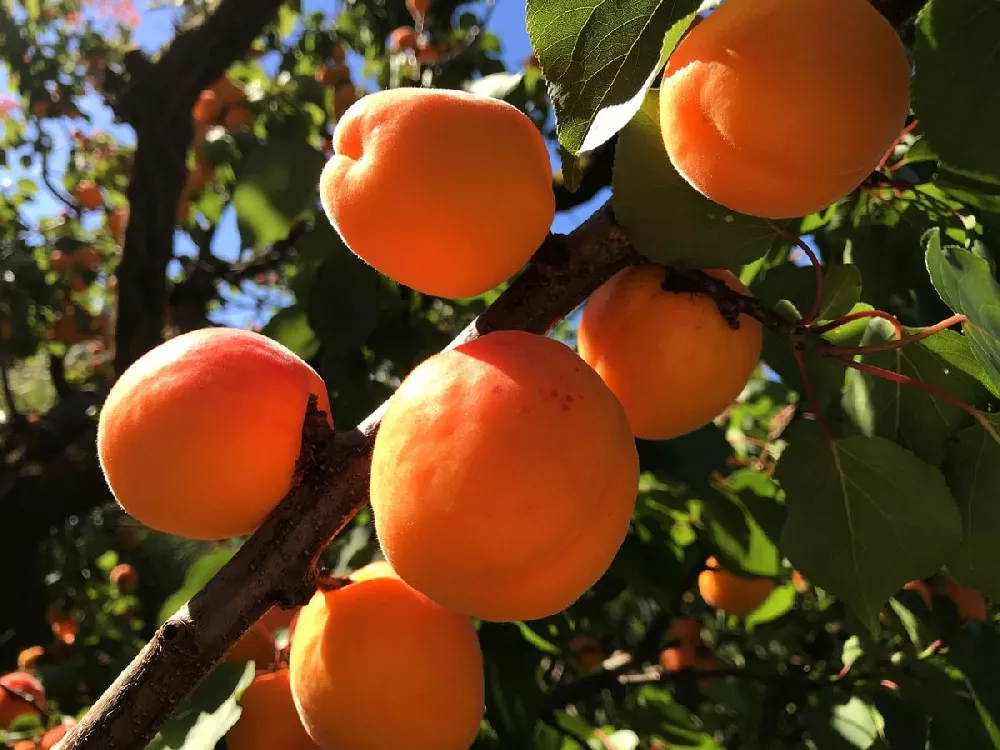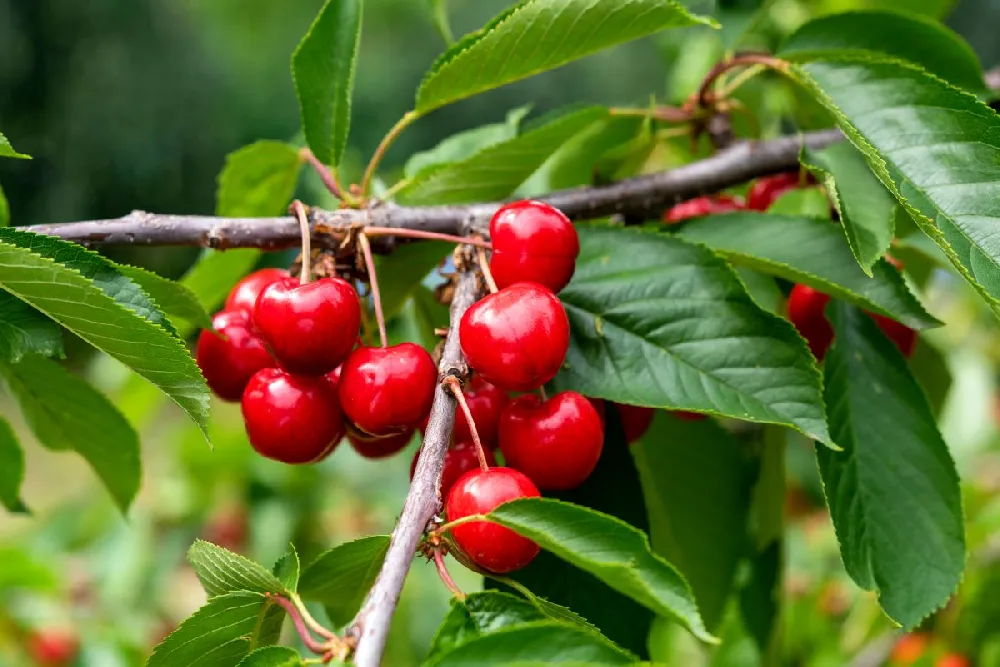- Home >
- Flowers >
- Trees and Plants with Pink Flowers >
- Moorpark Apricot Tree
Moorpark Apricot Tree for Sale - Buying & Growing Guide
- Ships in 1-2 days
- 1-Year Warranty Eligible
- Pots or accessories are not included unless specified in the product options.
Shipping Details:
Once your order is shipped, you’ll receive an email with a tracking number and estimated delivery date. Most orders ship immediately, but some items are seasonal and may only ship in spring or fall. These products are noted on the website.
If you love producing fresh fruits in your own yard and want to try your hand at growing apricots, then the Moorpark Apricot Tree is the plant that you need. Every summer, this tree, known scientifically as Prunus armeniaca, bears a large set of apricots that are both astoundingly flavorful and quite healthy as well. But before those fruits arrive, the Moorpark Apricot Tree will dazzle you with its brilliant springtime floral display.
- The Moorpark Apricot Tree produces juicy fruits that are full of vitamins each summer.
- In spring, this tree blooms with countless flowers that are mainly white with hints of red.
- This tree is cold hardy and survives outdoors throughout most of the United States.
Plant Care
Sunlight

The Moorpark Apricot Tree requires at least six hours of direct sunlight per day.
Watering
Plan on watering this plant about once per week or once every two during the growing season.
Fertilizing

Feed this plant with a nitrogen-rich fertilizer twice each year: once in the spring and once in the fall.
Planting and Care
Planting instructions
Before planting your Moorpark Apricot Tree, you should ensure that your planting location is one that receives at least six hours of unobstructed sunlight per day or more. The soil in your planting area should also be somewhat loose, making for excellent drainage. Once you find a location with such conditions in place, dig a hole that is as deep as the plant’s root ball is tall and at least twice as wide. Backfill with healthy soil and give your Moorpark Apricot Tree plenty of water throughout the planting process.
Watering and nutrients
The Moorpark Apricot Tree is a plant that has relatively high moisture needs. Throughout most of its life, this tree will need water about once per week or once every 10 to 14 days during the growing season. However, you should also monitor the rainfall and hold off on your regular watering if your tree has received about an inch or more of natural rainfall during the week. You should feed your Moorpark Apricot Tree once during the early spring and once during the fall. For both feedings, you should use a fertilizer that has plenty of nitrogen.
Pollination
Pollination typically takes place quite easily for the Moorpark Apricot Tree. Each spring, this tree blooms with many flowers that attract bees and other pollinator insects. Since this tree is self-fertile, you need only one if you wish to produce a healthy harvest. However, if you plant more than one Moorpark Apricot Tree, which allows for cross-pollination, then you can expect your harvest to be considerably larger. As such, anyone who wants to maximize their apricot production should plant multiple trees.
Pruning
The ideal time to prune a Moorpark Apricot Tree is during the summer—just after the harvest. Generally, you can keep your pruning for this tree somewhat light and focus on thinning the canopy to promote air circulation. It is also quite beneficial to remove any branch that is dead, damaged or diseased. Pruning immediately after harvest will also give this plant time to heal before the cold winter weather arrives. When pruning, be sure to use sharp and sterile tools to preserve your tree’s health.
Pests, diseases and animals
Moorpark Apricot Trees can run into issues with both pests and diseases throughout their lives. The most common diseases that will harm this tree are powdery mildew, root rot and canker. Most of those issues arise as a result of excessive amounts of moisture, either in the soil or in the tree’s canopy. Insects can also be a prevalent problem for this tree. Some of the most common pests that will harm your Moorpark Apricot Tree are mites, Japanese beetles and borers.
Harvesting
The harvest time for a Moorpark Apricot Tree is relatively long as it spans from the start of July through most of August. During that time, you’ll notice that each fruit will ripen at a different rate, rather than all of the fruits turning ripe at once. A ripe apricot will be firm with a bit of softness. It will also have an orange or yellow color and give off a strong scent of sweetness. Any apricot that does not have that color, scent or texture should remain on the tree to ripen further.
Achieving maximum results
Although many gardeners believe it is best to prune a Moorpark Apricot Tree in early spring, this is not the ideal approach. Since Moorpark Apricot Trees bloom on old wood, pruning during late winter and early spring risks removing the season’s blooms. If this occurs, your Moorpark Apricot Tree may not produce any fruits later in the year. Also, be careful about growing this plant near roses. If you notice that roses near your Moorpark Apricot Tree have contracted powdery mildew, there is a high likelihood that your tree will contract the same condition shortly.
FAQs
Where does the Moorpark Apricot Tree come from?
The first apricot trees likely appeared in Eurasia several thousand years ago. Over time, those trees spread throughout the continent and became quite popular in Europe. Many centuries later, during the reign of King Henry the 8th of England, apricots trees arrived in England from Italy. Following that arrival, Lord Anson eventually created the Moorpark Apricot Tree variety, which soon became one of the most popular varieties in the nation.
How much space does a Moorpark Apricot Tree need?
The Moorpark Apricot Tree grows to be about 15 to 20 feet tall with a spread that reaches a similar dimension. That considerable size means that you should be careful about your spacing when planting this tree. Generally, it is best to give each of your Moorpark apricot trees about 25 feet of space in every direction, which allows them to develop fully as they mature.
What does the Moorpark Apricot Taste like?
Part of the reason that the Moorpark Apricot Tree is so popular is that this tree's fruits are incredibly delicious. Moorpark Apricots are very juicy and have an intensely sweet flavor. These fruits are lovely to enjoy raw, but you can dry them or can them as well. Best of all, these fruits are not only tasty, but they are also healthy, as they contain plenty of vitamins and antioxidants.
Compare Similar Products
You can't add more Product Name - Product size to the cart.
OK








